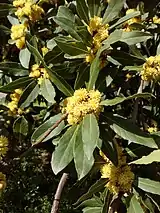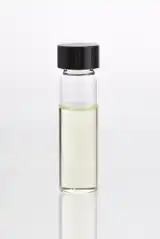Laurus nobilis
Laurus nobilis /ˈlɔːrəs ˈnɒbɪlɪs/[2][3] is an aromatic evergreen tree or large shrub with green, glabrous (smooth) leaves. It is in the flowering plant family Lauraceae. It is native to the Mediterranean region and is used as bay leaf for seasoning in cooking. Its common names include bay tree (esp. United Kingdom),[4]: 84 bay laurel, sweet bay, true laurel, Grecian laurel,[5] or simply laurel. Laurus nobilis figures prominently in classical Greco-Roman culture.
| Laurus nobilis | |
|---|---|
.jpg.webp) | |
| Bay laurel (Laurus nobilis) leaves and branches | |
| Scientific classification | |
| Kingdom: | Plantae |
| Clade: | Tracheophytes |
| Clade: | Angiosperms |
| Clade: | Magnoliids |
| Order: | Laurales |
| Family: | Lauraceae |
| Genus: | Laurus |
| Species: | L. nobilis |
| Binomial name | |
| Laurus nobilis | |
Worldwide, many other kinds of plants in diverse families are also called "bay" or "laurel", generally due to similarity of foliage or aroma to Laurus nobilis.
Description



The laurel is an evergreen shrub or small tree, variable in size and sometimes reaching 7–18 m (23–59 ft) tall.[4] The genus Laurus includes four accepted species,[6] whose diagnostic key characters often overlap.[7]
The bay laurel is dioecious (unisexual), with male and female flowers on separate plants.[8] Each flower is pale yellow-green, about 1 cm (3⁄8 in) diameter, and they are borne in pairs beside a leaf. The leaves are glabrous, 6–12 cm (2–5 in) long and 2–4 cm (3⁄4–1+5⁄8 in) broad, with an entire (untoothed) margin. On some leaves the margin undulates.[8] The fruit is a small, shiny black drupe-like berry[9][10] about 1 cm (3⁄8 in) long[8] that contains one seed.[11][4]
Ecology
Laurus nobilis is a widespread relict of the laurel forests that originally covered much of the Mediterranean Basin when the climate of the region was more humid. With the drying of the Mediterranean during the Pliocene era, the laurel forests gradually retreated, and were replaced by the more drought-tolerant sclerophyll plant communities familiar today. Most of the last remaining laurel forests around the Mediterranean are believed to have disappeared approximately ten thousand years ago, although some remnants still persist in the mountains of southern Turkey, northern Syria, southern Spain, north-central Portugal, northern Morocco, the Canary Islands and in Madeira.
Human uses
Food
The plant is the source of several popular herbs and one spice used in a wide variety of recipes, particularly among Mediterranean cuisines.[8] Most commonly, the aromatic leaves are added whole to Italian pasta sauces. They are typically removed from dishes before serving, unless used as a simple garnish.[12] Whole bay leaves have a long shelf life of about one year, under normal temperature and humidity.[12] Whole bay leaves are used almost exclusively as flavor agents during the food preparation stage.
Ground bay leaves, however, can be ingested safely and are often used in soups and stocks, as well as being a common addition to a Bloody Mary.[12] Dried laurel berries and pressed leaf oil can both be used as robust spices, and the wood can be burnt for strong smoke flavoring.[12]
Ornamental
Laurus nobilis is widely cultivated as an ornamental plant in regions with Mediterranean or oceanic climates, and as a house plant or greenhouse plant in colder regions. It is used in topiary to create single erect stems with ball-shaped, box-shaped or twisted crowns; also for low hedges. However it is slow-growing and may take several years to reach the desired height.[13] Together with a gold form, L. nobilis 'Aurea' [14] and a willow-leaved form L. nobilis f. angustifolia,[15] it has gained the Royal Horticultural Society's Award of Garden Merit.[16]
One of the most important pests affecting ornamental laurels is caused by the jumping plant louse Trioza alacris, which induces the curling and thickening of the edge of the leaves for the development of the insect's nymphs, eventually creating a necrosed gall.[17] The species is also affected by the scale insect Coccus hesperidum.[17]
Alternative medicine

In herbal medicine, aqueous extracts of bay laurel have been used as an astringent and salve for open wounds.[18] It is also used in massage therapy and aromatherapy.[19] A folk remedy for rashes caused by poison ivy, poison oak, and stinging nettle is a poultice soaked in boiled bay leaves.[20] The Roman naturalist Pliny the Elder listed a variety of conditions which laurel oil was supposed to treat: paralysis, spasms, sciatica, bruises, headaches, catarrhs, ear infections, and rheumatism.[21]
Other uses
Laurel oil is a secondary ingredient, and the distinguishing fragrant characteristic of Aleppo soap.
Symbolism
Greece
In Greek, the plant is called daphne, after the mythic mountain nymph of the same name. In the myth of Apollo and Daphne, the god Apollo fell in love with Daphne, a priestess of Gaia (Mother Earth), and when he tried to seduce her she pleaded for help to Gaia, who transported her to Crete. In Daphne's place Gaia left a laurel tree, from which Apollo fashioned wreaths to console himself.[22] Other versions of the myth, including that of the Roman poet Ovid, state that Daphne was transformed directly into a laurel tree.[23]
Bay laurel was used to fashion the laurel wreath of ancient Greece, a symbol of highest status. A wreath of bay laurels was given as the prize at the Pythian Games because the games were in honor of Apollo, and the laurel was one of his symbols. According to the poet Lucian, the priestess of Apollo known as the Pythia reputedly chewed laurel leaves from a sacred tree growing inside the temple to induce the enthusiasmos (trance) from which she uttered the oracular prophecies for which she was famous.[24] Some accounts starting in the fourth century BC describe her as shaking a laurel branch while delivering her prophecies. Those who received promising omens from the Pythia were crowned with laurel wreaths as a symbol of Apollo's favor.[25]
Rome
The symbolism carried over to Roman culture, which held the laurel as a symbol of victory.[26] It was also associated with immortality,[27] with ritual purification, prosperity and health.[28][29] It is also the source of the words baccalaureate and poet laureate, as well as the expressions "assume the laurel" and "resting on one's laurels".
Pliny the Elder stated that the laurel was not permitted for "profane" uses – lighting it on fire at altars "for the propitiation of divinities" was strictly forbidden, because "it is very evident that the laurel protests against such usage by crackling as it does in the fire, thus, in a manner, giving expression to its abhorrence of such treatment".[30]
Laurel was closely associated with the Roman Emperors, beginning with Augustus. Two Laurel trees flanked the entrance to Augustus' house on the Palatine Hill in Rome, which itself was connected to the Temple of Apollo Palatinus, which Augustus had built. Thus, the laurels had the dual purpose of advertising Augustus' victory in the Civil Wars and his close association with Apollo.[28] Suetonius relates the story of Augustus' wife, and Rome's first Empress, Livia, who planted a sprig of laurel on the grounds of her villa at Prima Porta after an eagle dropped a hen with the sprig clutched in its beak onto her lap.[31] The sprig grew into a full-size tree which fostered an entire grove of laurel trees, which were in turn added to by subsequent Emperors when they celebrated a triumph. The Emperors in the Julio-Claudian dynasty all sourced their Laurel wreaths from the original tree planted by Livia. It was taken as an omen of the impending end of the Julio-Claudian dynasty that in the reign of Nero the entire grove died, shortly before he was assassinated.[31] Rome's second Emperor Tiberius wore wreaths of laurel whenever there was stormy weather because it was widely believed that Laurel trees were immune to lightning strikes, affording protection to those who brandished it.[32][33][29] One reason for this belief is because laurel crackles loudly when on fire. It led ancient Romans to believe the plant was inhabited by a "heavenly fire demon", and was therefore "immune" from outer threats like fire or lightning.[32]
In modern Italy, laurel wreaths are worn as a crown by graduating school students.[34]
East Asia
An early Chinese etiological myth for the phases of the moon involved a great forest or tree which quickly grew and lost its leaves and flowers every month. After the Sui and Tang dynasties, this was sometimes connected to a woodsman named Wu Gang, sentenced to cut at a self-repairing tree as a punishment for varying offenses. The tree was originally identified as a 桂 (guì) and described in the terms of the osmanthus (Osmanthus fragrans, now known in Chinese as the 桂花 or "gui flower"), whose blossoms are still used to flavor wine and confections for the Mid-Autumn Festival. However, in English, it is often associated with the more well-known cassia (Cinnamomum cassia, now known in Chinese as the 肉桂 or "meat gui") while, in modern Chinese, it has instead become associated with the Mediterranean laurel. By the Qing dynasty, the chengyu "pluck osmanthus in the Toad Palace" (蟾宫折桂, Chángōng zhé guì) meant passing the imperial examinations,[35][36][37] which were held around the time of the lunar festival. The similar association in Europe of laurels with victory and success led to its translation into Chinese as the 月桂 or "Moon gui".
Finland

The laurel leaves in the coat of arms of Kaskinen, Finland (Swedish: Kaskö) may have been meant to refer to local flowering, but its origin may also be in the name of the family Bladh (Swedish: blad; 'leaf'); two members of the family – a father and a son – acquired both town rights and the status of staple town for the village at the time.[38][39]
Chemical constituents
The most abundant component found in laurel essential oil is 1,8-cineole, also called eucalyptol. The leaves contain about 1.3% essential oils (ol. lauri folii), consisting of 45% eucalyptol, 12% other terpenes, 8–12% terpinyl acetate, 3–4% sesquiterpenes, 3% methyleugenol, and other α- and β-pinenes, phellandrene, linalool, geraniol, and terpineol.[40] It contains lauric acid also.
Both essential and fatty oils are present in the fruit. The fruit is pressed and water-extracted to obtain these products. The fruit contains up to 30% fatty oils and about 1% essential oils (terpenes, sesquiterpenes, alcohols, and ketones). This laurel oil is the characteristic ingredient of Aleppo soap. The chemical compound lauroside B has been isolated from Laurus nobilis.[41]
References
- Khela, S.; Wilson, B. (2018). "Laurus nobilis". IUCN Red List of Threatened Species. 2018: e.T203351A119996864. doi:10.2305/IUCN.UK.2018-1.RLTS.T203351A119996864.en. Retrieved 19 November 2021.
- "Laurus". Merriam-Webster.com Dictionary.
- "Botanary: nobilis". Dave's Garden. Retrieved December 19, 2022.
- Stace, C. A. (2010). New Flora of the British Isles (Third ed.). Cambridge, U.K.: Cambridge University Press. ISBN 9780521707725.
- Brown, R.W. (1956). Composition of scientific words: A manual of methods and a lexicon of materials for the practice of logotechnics. Washington, D.C.: Smithsonian Institution Press.
- "The Plant List:Laurus". Royal Botanic Gardens, Kew and Missouri Botanic Garden. Retrieved 20 March 2017.
- Mabberley, The Plant-Book: A Portable Dictionary of the Vascular Plants, Cambridge University Press, 19 Jun 1997
- Vaughan, John Griffith; Geissler, Catherine (2009). The New Oxford Book of Food Plants. Oxford: Oxford University Press. p. 150. ISBN 978-0-19-954946-7. Retrieved 2010-12-31.
- "Laurus nobilis - Plant Finder". www.missouribotanicalgarden.org. Retrieved 2023-08-23.
- Flora Europaea. Cambridge: Cambridge University Press. 1964. pp. Volume 1 page 246.
- Konstantinidou, E.; Takos, I.; Merou, T. (2008). "Desiccation and storage behavior of bay laurel (Laurus nobilis L.) seeds". European Journal of Forest Research. 127 (2): 125–131. doi:10.1007/s10342-007-0189-z. S2CID 28898196.
- Green, Aliza (2006). Field Guide to Herbs & Spices. Philadelphia: Quirk Books. ISBN 978-1-59474-082-4. Retrieved 2010-12-31.
- Brickell, Christopher, ed. (2008). The Royal Horticultural Society A-Z Encyclopedia of Garden Plants. United Kingdom: Dorling Kindersley. p. 614. ISBN 9781405332965.
- "Laurus nobilis 'Aurea'". RHS. Retrieved 1 October 2020.
- "RHS Plantfinder – Laurus nobilis f. angustifolia". Retrieved 19 March 2018.
- "Laurus nobilis". RHS. Retrieved 1 October 2020.
- De Alfonso, M.; Olmeda1, A.; Rodrigo, E.; Xamaní, P.; Sánchez–Domingo, A.; Laborda, R. (2014). "Evaluación de diferentes métodos de control de plagas en cultivo de laurel ornamental e impacto en la fauna útil asociada" (PDF). VI Jornadas Ibéricas de Horticultura Ornamental: Las buenas prácticas agrícolas en horticultura ornamental. pp. 50–51. ISBN 978-84-617-3020-9.
- Nayak, S; Nalabothu, P; Sandiford, S; Bhogadi, V; Adogwa, A (2006). "Evaluation of wound healing activity of Allamanda cathartica. L. and Laurus nobilis. L. extracts on rats". BMC Complementary and Alternative Medicine. 6: 12. doi:10.1186/1472-6882-6-12. PMC 1456996. PMID 16597335..
- Encyclopedia of Herbs. "Bay Laurel: Laurus nobilis". AllNatural.net. Archived from the original on 19 November 2010. Retrieved 2010-12-31.
- Wood, Jamie; Steinke, Lisa (2010). The Faerie's Guide to Green Magick from the Garden. New York: Random House. p. 43. ISBN 978-1-58761-354-8. Retrieved 2010-12-31.
- Pliny the Elder. Natural History. p. XXIII.43.
- Graves, Robert (1955). The Greek Myths: Part 1. Penguin Books. pp. 21.K–21.L.
- "The Metamorphoses". Translated by Kline, A. S. 2000. Archived from the original on April 19, 2005. Retrieved 2017-11-17.
{{cite web}}: CS1 maint: bot: original URL status unknown (link) - Scott, Michael (2014). Delphi. Princeton University Press. p. 20.
- Swahn, J. O. (1991). The Lore of Spices. Random House. p. 40.
- De Cleene, Marcel; Lejeune, Marie Claire (2003). Compendium of symbolic and ritual plants in Europe. Vol. 1. Man & Culture. p. 129. OCLC 482791069.
- Pliny the Elder. Natural History Book XV.39.
- Giesecke, Annette (2014). The Mythology of Plants: Botanical Lore from Ancient Greece and Rome. J. Paul Getty Museum. pp. 35–36.
- Pliny the Elder. Natural History. Book XV, 35.
- Pliny the Elder. Natural History. Book XV.135.
- Suetonius. Galba. Book 7, 1.
- McCartney, Eugene S. (1929). "Why Did Tiberius Wear Laurel in the Form of a Crown During Thunder Storms". Classical Philology. Classical Philology. 24 (2): 201–203. doi:10.1086/361124. S2CID 162098134.
- Suetonius. Tiberius, 69.
- Gabriella Massara, https://giftsitter.com/it/blog/laurea-perche-si-incorona-il-laureato-con-lalloro "Corona d’alloro fai da te", retrieved April 2018
- Brendon, Juliet et al. The Moon Year: A Record of Chinese Customs and Festivals, p. 410. Kelly & Walsh, 1927. Reprinted Routledge (Abingdon), 2011. Accessed 13 November 2013.
- Zdic (2013). "蟾宫折桂". Accessed 13 November 2013. (in Chinese)
- 杜近芳 [Du Jinfang] (2003). 《红楼梦汉英习语词典》 ["A Dictionary of Chinese Idioms in the Dream of the Red Chamber"]. Accessed 13 November 2013. (in English and Chinese)
- Suomen kunnallisvaakunat (in Finnish). Suomen Kunnallisliitto. 1982. p. 117. ISBN 951-773-085-3.
- Boyko, Dm. A. (2013). Геральдика Великого Княжества Финляндского [Heraldry of the Grand Duchy of Finland]. Zaporizhzhia. (in Russian)
- Kilic, Ayben; Hafizoglu, Harzemsah; Kollmannsberger, Hubert; Nitz, Siegfried (2004). "Volatile Constituents and Key Odorants in Leaves, Buds, Flowers, and Fruits of Laurus nobilisL". Journal of Agricultural and Food Chemistry. 52 (6): 1601–6. doi:10.1021/jf0306237. PMID 15030218.
- Panza, E; Tersigni, M; Iorizzi, M; Zollo, F; De Marino, S; Festa, C; Napolitano, M; Castello, G; et al. (2011). "Lauroside B, a megastigmane glycoside from Laurus nobilis (bay laurel) leaves, induces apoptosis in human melanoma cell lines by inhibiting NF-κB activation". Journal of Natural Products. 74 (2): 228–33. doi:10.1021/np100688g. PMID 21188975.
External links
- Hogan, C.Michael (2010). "Laurus Nobilis L." Encyclopedia of Life. Retrieved 2010-12-30.
- MeSH: Laurus – Laurus nobilis (Bay Laurel)
- PubMed search: "Laurus"[MAJR]
- Laurus nobilis – Israel Wildflowers and native plants

